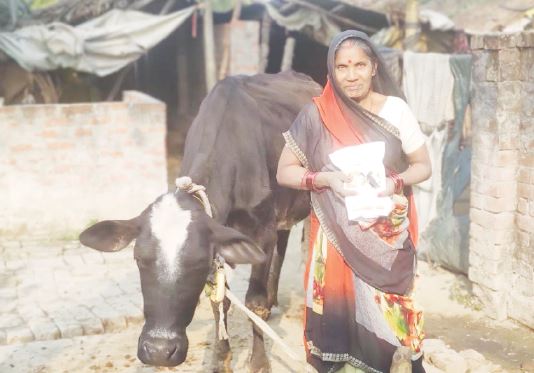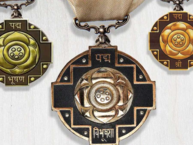Animal husbandry refers to the raising and selective breeding of livestock. It is the management and care of animals in which the genetic traits and behavior of animals are further developed for profit. India’s livestock sector is the largest in the world. About 20.5 million people depend on livestock for their livelihood. Livestock contributes 16% to the income of small agricultural households, compared to an average of 14% for all rural households. Livestock provides livelihood to two-thirds of the rural community. It also employs about 8.8% of the population in India. India has vast livestock resources. The livestock sector contributes 4.11% of the GDP and 25.6% of the total agricultural GDP. Livestock income has become an important secondary source of income for rural households and has played an important role in achieving the goal of doubling farmers’ income.
Livestock plays an important role in the economy of farmers. Farmers in India maintain a mixed farming system i.e. combination of crop and livestock where the output of one enterprise becomes the input of another enterprise thereby realizing resource efficiency. Livestock serves farmers in a variety of ways. Livestock is a source of subsidiary income for many families in India, especially the resource-poor who keep a few heads of animals. Milking cows and buffaloes through the sale of milk will provide regular income to the cattle rearers. Animals like sheep and goats serve as a source of income to meet emergencies such as marriages, treatment of sick persons, education of children, repair of houses, etc. Animals also serve as moving banks and assets that provide economic security to owners.
Due to low literacy and unskilled, a large number of people in India depend on agriculture for their livelihood. But agriculture being seasonal can employ a maximum of 180 days in a year. People with little land depend on livestock to use their labor during the low agricultural season. Animal products such as milk, meat, and eggs are an important source of animal protein for members of pastoralists. The per capita availability of milk is about 355 g/day; Egg is 69/year;The animals provide social security to the owners in terms of their status in society. Households especially landless who have animals, their condition is better than those who do not have animals. Gifting of animals is a very common phenomenon during weddings in different parts of the country. Animal husbandry is a part of Indian culture. Animals are used for various social and religious functions. sing for housewarming ceremonies; rams, deer, and chickens for sacrifice in the festive season; Bulls and cows are worshiped during various religious functions. Many owners develop an attachment to their animals.Animal husbandry promotes gender equality. More than three-quarters of the labor demand in livestock production is met by women. The share of women’s employment in the livestock sector is around 90% in Punjab and Haryana where dairying is a major activity and animals are stall-fed. Bulls are the backbone of Indian agriculture. Despite great progress in the use of mechanical power in Indian agricultural operations, Indian farmers, especially in rural areas, still depend on oxen for various agricultural operations.
Bullocks are saving a lot on fuel which is an essential input for using mechanical power like tractors, combine harvesters, etc. Apart from oxen, pack animals like camels, horses, donkeys, mules, etc. are being used extensively for carrying goods in different parts of the country. In conditions such as hilly terrain, mules and ponies serve as the only options for transporting goods. Similarly, the army has to depend on these animals for the transportation of various items in high-altitude areas. In rural areas, cow dung is used for many purposes including fuel (dung cake), fertilizer (farm yard manure), and plastering material (poor man’s cement).Improving the productivity of farm animals is one of the major challenges. The average annual milk yield of Indian cattle is 1172 kg, which is about 50 percent of the world average. frequent outbreaks of diseases such as foot-and-mouth disease, black quarter infection; Influenza, etc. affect livestock health and reduce productivity. India’s large population of ruminants contributes to the emission of greenhouse gases. A major challenge will be to reduce greenhouse gases through mitigation and adaptation strategies.
Crossbreeding of indigenous species with foreign stock has been successful only to a limited extent to increase the genetic potential of different species. Limited AI services due to a lack of quality germplasm, infrastructure, and technical manpower coupled with poor conception rates after AI have been major constraints. The sector received about 12 percent of total public expenditure on agriculture and allied sectors, which is disproportionately low compared to its contribution to agricultural GDP. This sector has been neglected by financial institutions.
Meat production and markets: Similarly, slaughter facilities are inadequate. About half of the total meat production comes from unregistered, temporary slaughterhouses. The cost of marketing and transaction of livestock products is high at 15-20 percent of the selling price. With a growing population, continuous rise in food inflation, and agriculture being the primary occupation of the majority of India’s population amidst an unfortunate rise in farmer suicides, the practice of animal husbandry is no longer an option, but a necessity in the contemporary scenario. Its successful, sustainable, and efficient implementation will improve the socio-economic condition of the lower strata of our society. By linking animal husbandry with the food processing industry, agriculture, research, and patents, India has every potential to become the nutritional powerhouse of the world. Animal husbandry is an essential hope, a definite wish, and an essential panacea for India as well as the world.
The latest
Election Commission extends polling time in Telangana due to heatwave conditions
The hours of polling will be 7am to 6pm in the Adilabad, Peddapalle, Karimnagar, Nizamabad, Zahirabad, Medak, Malkajgiri, Secunderabad, Hyderabad, Chevella, Mahbubnagar, Nagarkurnool (SC), Nalgonda, Bhongir, Warangal (SC), Mahabubabad and Khammam.
Online nomination for Padma Awards-2025 begins
The Padma Awards, namely, Padma Vibhushan, Padma Bhushan and Padma Shri, are amongst the highest civilian awards of the country.
Zaheerabad voters have full faith in BRS for their welfare: Lok Sabha candidate Gali Anil Kumar
By M. Rajanikanth | Bureau Chief
The Bharat Rashtra Samithi...
Tamil Nadu protests as medium pacer T. Natarajan excluded from T20 World Cup
"Delhi" has MOST of the time turned a blind eye to many immensely talented athletes from the south ! Many Athletes cutting across sports AND ideological bearings KNOW this ! Glad Badri Spoke his mind. Natarajan and our other boys TRULY deserve better
Rockwell Automation to open new manufacturing facility in Chennai
New Delhi: Rockwell Automation, the world’s largest company dedicated...
Centre conducts workshop to bridge gap between fintechs and law enforcement agencies
New Delhi: The Department of Financial Services (DFS), Ministry...
© 2022 M/S. SIT PUBLICATIONS PVT LTD. All Rights Reserved.




